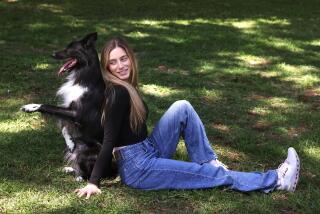Pudgy pups win best in show -- could their fame be making your pet fat?

This Labrador retriever took part in the Crufts dog show in Birmingham, England, in March. In years past, a new study estimates, nearly two-thirds of labs competing in the competition were overweight.
Animals who compete in dog shows are supposed to be exemplars of their breeds, the very ideal of health, strength, beauty and poise.
But when a a pair of veterinarians evaluated nearly 1,000 photos of recent competitors at the large Crufts dog show in Britain, they found that more than a quarter were overweight -- their ribs hidden under soft layers of fat, their bodies barrel-shaped instead of contoured.
“They were in better shape than pet dogs, but they’re meant to be perfect specimens,” said Alex German, one of the vets performing the analysis. “They shouldn’t be overweight.”
German, who runs a pet obesity clinic at the University of Liverpool’s School of Veterinary Science, believes that the fitness of show dogs has a big impact on weight in pets, which has been rising in concert with obesity in people.
In Britain, about half of pet dogs are overweight, German said. A recent survey conducted by the North Carolina-based Assn. for Pet Obesity Prevention found that in 2014, 53% of U.S. dogs and 58% of U.S. cats were overweight. Like people, pets who pack on extra pounds have higher risks of diabetes, joint problems, cancers and other conditions.
“It’s the biggest medical problem in dogs and cats that we’re facing,” German said.
The idea to look for signs of obesity in the elite dogs who show at Crufts -- Britain’s national show and the largest in the world -- was part of a study conducted by German and a student, Z.R. Such. It was published Monday in the journal Veterinary Record.
The researchers believed that pet owners and the general public don’t know an overweight dog when they see one, German said, but “we wondered, ‘What could the reason be?’ And we thought, if you’re always seeing images of dogs in the media that are actually overweight, it recalibrates it in your mind, and overweight seems normal.”
Pictures of dogs at widely followed Crufts, if the competing animals were in fact overweight, could be just the sort of images driving false perceptions about healthy pet weight.
To see if chubby dogs were winning awards, the researchers first identified 28 breeds that they would seek: 14 that were prone to obesity (Labrador retriever, cocker spaniel, golden retriever, basset hound, beagle, dachshund, Shetland sheepdog, Cairn terrier, Scottish terrier, cavalier King Charles spaniel, pug, dalmatian, boxer and Rottweiler) and 14 that were not (Hungarian vizsla, springer spaniel, flat-coated retriever, Rhodesian ridgeback, Basset Griffon Vendeen, Irish wolfhound, Welsh corgi, Border terrier, West Highland white terrier, Chihuahua, bichon frise, standard poodle, bull mastiff and Dobermann.)
Such used Google Images to find side-view photos of 20 male and 20 female dogs from each breed. Dogs had be adults, and had to have placed between first and fifth place in their class at Crufts between 2001 and 2013.
Because some dogs’ long hair made it hard to assess their weight, the analysis was narrowed down to 960 photos. German used a previously validated method to visually assess whether the dogs were underweight, healthy or overweight. He looked for fat around the abdomen, rib cage, neck and hips, seeking clear definition around the chest and a tuck in the abdomen much like a waist.
Overall, 252 of the dogs he assessed -- 26% -- were overweight. (None was underweight, and the rest were in ideal condition.) Around two-thirds of pictures of Labrador retrievers and basset hounds depicted overweight dogs. Among pugs, the number ballooned to 80%.
German said that the Kennel Club in Britain is aware of the problem of pet obesity, and that breed standards make it clear that some breeds should “have substance, but it shouldn’t be substance that’s created by body fat.”
He believes that judges aren’t applying the standards properly, but hopes that might soon change -- and that pet owners will learn to recalibrate their ideas of what is and isn’t a healthy weight.
“Until overweight dogs aren’t scoring well at shows, you’ll have a problem,” he said.
For more on science and health, follow me on Twitter: @LATerynbrown







